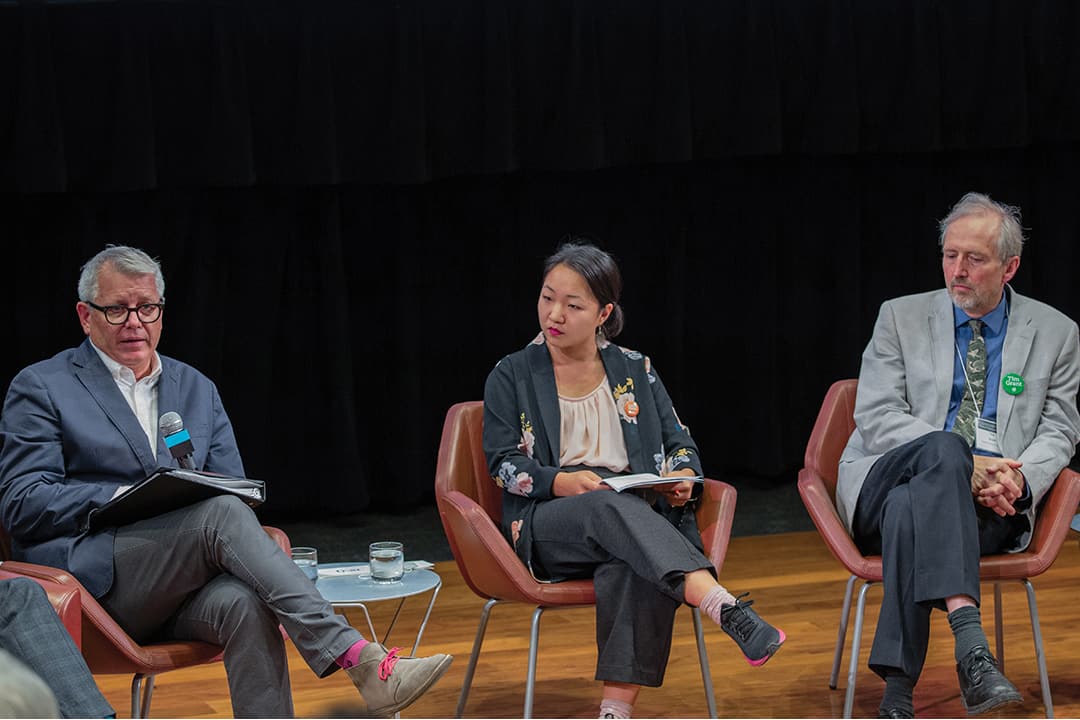There were no major roadblocks at a transportation debate for Toronto federal candidates at Innis Town Hall on September 17, as Liberal Party, New Democratic Party (NDP), and Green Party members largely reached a consensus.
The debate, hosted by Transport Futures, featured two of the candidates for the Spadina–Fort York federal riding: incumbent Adam Vaughan of the Liberal Party and Diana Yoon of the New Democratic Party (NDP), as well as Tim Grant — the Green Party candidate for the University–Rosedale federal riding.
Absent from the debate were invited candidates of the Conservative Party and Renata Ford of the People’s Party of Canada.
The conversation was moderated by Ben Spurr, a transportation reporter for the Toronto Star. While the discussion covered a breadth of topics, three issues persistently came up during the evening: environmental impact, safety, and funding for transportation.
Platform comparisons
Vaughan kicked off the debate by announcing his party’s intentions to deliver a $180 billion infrastructure program — $28 billion of which will be allocated to public transit. Under this plan, funds will be distributed on a per-rider as opposed to a per-capita basis. The TTC will receive just under $4.9 billion over a 10-year period, with pedestrian and cycling infrastructure also being supported under the Liberal plan.
The hallmark of the NDP’s platform is fare-free public transit. Yoon emphasized the importance of this policy for low-income and marginalized communities who have faced decades of Liberal and Conservative underfunding on the topic of transportation.
Grant advocated for his party’s transportation strategy, which he described as a “hub and spoke” system. The Green’s plan proposes the use of rail as ‘the hub’ and electric buses, the ‘spokes,’ which would connect more remote areas to a central rail system. The aim of this vision is to use as much electric transportation as possible by 2040.
Environmental implications of transportation
The debate touched on the impact of public transit on the climate crisis at length, as the candidates spoke on the future of Toronto’s public transportation. All three candidates made impassioned arguments for the role of zero-emission cars and public transit in their plans to fight the crisis.
Yoon, who worked at the City of Toronto’s Atmospheric Fund, said that the “motivating force” for her candidacy was the climate crisis, emphasizing equity in her policies.
Bike lane accessibility also played a large role in the conversation, which prompted discussion around the question of whether or not the lack of infrastructure was the true problem surrounding environmentally-friendly transportation.
Yoon attributed the alleged lack of investment in proper infrastructure from the federal government to be a concern. Grant disagreed, blaming increased congestion in the city on the development of ride-sharing applications instead.
While the NDP, Liberals, and Green Party candidates all agreed on providing tax incentives for the creation of zero-emission vehicles, Grant made an effort to note that electric busses, more than cars, are a “big part of the answer.”
“What we really need is harder, bigger, and more ambitious federal targets on vehicle use and on carbon reduction,” argued Grant.
Transportation and safety
Pedestrian and cyclist safety was a priority for all candidates: “I am not a cyclist because, frankly, I am concerned about my own safety,” Yoon said, and argued that Toronto’s poor urban street design is the root of the problem.
Vaughan referred to his work as a city counsellor in establishing more bike lanes, and he credited the King Street pilot for taking a step toward safer transit. He continued by saying that federal investment was necessary to design safer transportation policies.
Grant’s safety concerns were focused on train rail safety. Notably, he pointed toward the Dupont Street corridor, where the City of Toronto cited a lack of rail safety in blocking a condo development from being built too close to the rail.
The Green Party candidate argued that rail companies need to have higher standards and include the implementation of safety options such as electronic sensors. The concern for the Dupont Street corridor was shared by Vaughan, as he agreed that bigger security measures need to be taken to avoid a catastrophe like the Lac-Mégantic rail disaster in 2013.


